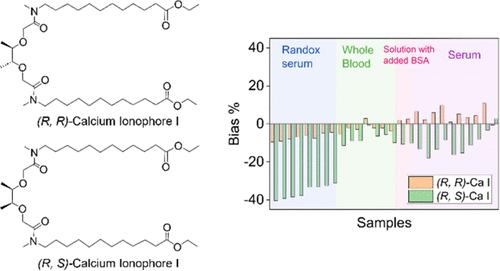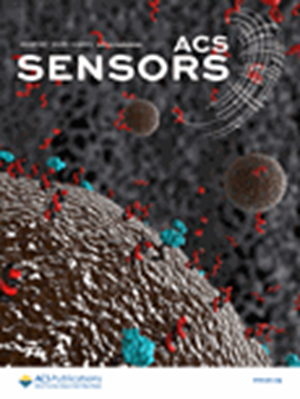Complexation Behavior and Clinical Assessment of Isomeric Calcium Ionophores of ETH 1001 in Polymeric Ion-Selective Membranes
IF 8.2
1区 化学
Q1 CHEMISTRY, ANALYTICAL
引用次数: 0
Abstract
Calcium ions are crucial in numerous physiological processes, and their precise measurement is important for many clinical diagnostics and therapeutic interventions. Traditional detection methods, such as atomic absorption spectroscopy, cannot meet clinical requirements, as they measure total calcium instead of the clinically relevant ionized form (Ca2+). Ion-selective electrodes (ISEs) provide a convenient, accurate, and specific method for Ca2+ determination. Here, two isomeric calcium ionophores (R,R)-calcium ionophore I, also known as ETH 1001, and (R,S)-calcium ionophore I are synthesized and characterized for the analysis of whole blood samples with the Eaglenos blood gas analyzer (model: EG-i30) equipped with test cartridges containing screen-printed electrodes. (R,R)-Calcium ionophore I demonstrated excellent precision in whole blood samples, achieving an average bias of −2.2% compared with the available gold standard. On the other hand, the (R,S) isomer was not satisfactory, exhibiting a bias of up to −20%. Ion transfer voltammetry at thin membrane films gave information about the complex stoichiometry, complex formation constants, and ion selectivity for the two isomeric ionophores. A stoichiometry of the Ca2+-ionophore complex was confirmed to be 1:2 for both ionophores, while the (R,R) isomer gave 3.4 orders of magnitude larger complex formation constants and a modestly higher selectivity. While these data are valuable, the poor performance of membranes containing the (R,S) isomer is not directly apparent from the fundamental binding characteristics. It may be caused by interference from lipophilic blood sample components and/or surface adsorption processes, suggesting that routine selectivity characterizations of membranes containing selective ionophores are insufficient to assess their usefulness in clinical applications.

ETH 1001 的异构钙离子团在聚合物离子选择膜中的络合行为和临床评估
钙离子在许多生理过程中都至关重要,对它们的精确测量对许多临床诊断和治疗干预都很重要。原子吸收光谱等传统检测方法无法满足临床要求,因为它们测量的是总钙而不是与临床相关的离子形式(Ca2+)。离子选择性电极(ISE)提供了一种方便、准确和特异的 Ca2+ 检测方法。在此,我们合成了两种异构体钙离子体(R,R)-钙离子体 I(又称 ETH 1001)和(R,S)-钙离子体 I,并对其进行了表征,用于使用配备丝网印刷电极测试盒的 Eaglenos 血液气体分析仪(型号:EG-i30)分析全血样本。(R,R)-钙离子团 I 在全血样本中表现出极佳的精确度,与现有的金标准相比,平均偏差为 -2.2%。另一方面,(R,S)异构体的效果并不理想,偏差高达-20%。薄膜上的离子转移伏安法提供了有关两种异构体离子发声体的络合物化学计量学、络合物形成常数和离子选择性的信息。经证实,两种离子体的 Ca2+-离子体复合物的化学计量比为 1:2,而(R,R)异构体的复合物形成常数要大 3.4 个数量级,选择性也略高。虽然这些数据很有价值,但从基本的结合特性来看,含有(R,S)异构体的膜性能不佳并不直接明显。这可能是由于亲脂性血液样本成分和/或表面吸附过程的干扰造成的,这表明对含有选择性离子团的膜进行常规选择性表征不足以评估其在临床应用中的实用性。
本文章由计算机程序翻译,如有差异,请以英文原文为准。
求助全文
约1分钟内获得全文
求助全文
来源期刊

ACS Sensors
Chemical Engineering-Bioengineering
CiteScore
14.50
自引率
3.40%
发文量
372
期刊介绍:
ACS Sensors is a peer-reviewed research journal that focuses on the dissemination of new and original knowledge in the field of sensor science, particularly those that selectively sense chemical or biological species or processes. The journal covers a broad range of topics, including but not limited to biosensors, chemical sensors, gas sensors, intracellular sensors, single molecule sensors, cell chips, and microfluidic devices. It aims to publish articles that address conceptual advances in sensing technology applicable to various types of analytes or application papers that report on the use of existing sensing concepts in new ways or for new analytes.
 求助内容:
求助内容: 应助结果提醒方式:
应助结果提醒方式:


